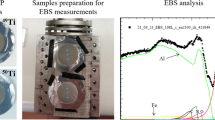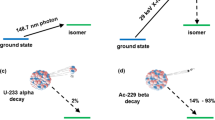Abstract
The goal of PASTA project (acronym for production with accelerator of 47Sc for theranostic applications) is the determination of excitation functions associated to several nuclear reactions, aimed at yielding the theranostic radionuclide 47Sc. This work reports the main results obtained by irradiating natural vanadium targets with proton beams up to 70 MeV. Particular care is also given to the co-production of 46Sc, the only isotopic contaminant with half-life longer than 47Sc. Experimental results are compared with theoretical studies by means of known nuclear reaction software tools that are publicly available.





Similar content being viewed by others
Change history
22 May 2021
A Correction to this paper has been published: https://doi.org/10.1007/s10967-021-07791-z
References
Qaim SM, Scholten B, Neumaier B (2018) J Radioanal Nucl Chem. https://doi.org/10.1007/s10967-018-6238-x
IAEA, CRP on therapeutic radiopharmaceuticals labelled with new emerging radionuclides (67Cu, 186Re, 47Sc), No. F22053, 2016-2020. http://cra.iaea.org/cra/explore-crps/all-active-by-programme.html
Müller C, Domnanich KA, Umbricht CA, Van Der Meulen NP (2018) Scandium and terbium radionuclides for radiotheranostics: current state of development towards clinical applications. Br J Radiol. https://doi.org/10.1259/bjr.20180074
Champion C, Quinto MA, Morgat C, Zanotti-Fregonara P, Hindié E (2016) Comparison between three promising ß-emitting radionuclides, 67Cu, 47Sc and 161Tb, with emphasis on doses delivered to minimal residual disease. Theranostics. https://doi.org/10.7150/thno.15132
Boschi A, Martini P, Costa V, Pagnoni A, Uccelli L (2019) Interdisciplinary tasks in the cyclotron production of radiometals for medical applications. The case of 47Sc as example. Molecules. https://doi.org/10.3390/molecules24030444
Huclier-Markai S, Alliot C, Kerdjoudj R, Mougin-Degraef M, Chouin N, Haddad F (2018) Promising scandium radionuclides for nuclear medicine: a review on the production and chemistry up to in vivo proofs of concept. Cancer Biother Radio. https://doi.org/10.1089/cbr.2018.2485
Esposito J et al (2019) LARAMED: a laboratory for radioisotopes of medical interest. Molecules. https://doi.org/10.3390/molecules24010020
Haddad F et al (2008) ARRONAX, a high-energy and high-intensity cyclotron for nuclear medicine. Nucl Med Mol Imaging. https://doi.org/10.1007/s00259-008-0802-5
Koning AJ, Hilarie S, Duijvesijn MC (2008) TALYS.1.0. In: Proceeding of the international conference on nuclear data for science and technology, April 22–27, 2007, Nice, France, EDP Sciences, p 211
Herman M et al (2007) EMPIRE: nuclear reaction model code system for data evaluation. Nucl Data Sheets 108:2655
Boehlen TT et al (2014) The FLUKA code: developments and challanges for high energy and medical applications. Nucl Data Sheets 120:211
Pupillo G et al (2018) New production cross sections for the theranostic radionuclide 67Cu. Nuclear Instr Methods Phys Res B. https://doi.org/10.1016/j.nimb.2017.10.022
IAEA Monitor Reactions (2017) https://www-nds.iaea.org/medical/monitor_reactions.html. Accessed Mar 2019
Ziegler JF, Ziegler MD, Biersack JP (2010) SRIM—the stopping and range of ions in matter. Nuclear Instr Methods Phys Res B 268:1818–1823
Otuka N et al (2017) Uncertainty propagation in activation cross section measurements. Radiat Phys Chem. https://doi.org/10.1016/j.radphyschem.2017.01.013
National Nuclear Data Center (NNDC), NuDat 2.7 database. https://www.nndc.bnl.gov/. Accessed Mar 2019
Experimental Nuclear Reaction Data (EXFOR). https://www-nds.iaea.org/exfor/exfor.htm. Accessed Mar 2019
Duchemin C, Guertin A, Haddad F, Michel N, Métivier V (2015) Production of medical isotopes from a thorium target irradiated by light charged particles up to 70 MeV. Phys Med Biol. https://doi.org/10.1088/0031-9155/60/3/931
Koning AJ, Delaroche JP (2003) Local and global nucleon optical models from 1 keV to 200 MeV. Nucl Phys A 713:231
Avrigeanu V, Hodgson PE, Avrigeanu M (1994) Global optical potentials for emitted alpha particles. Phys Rev C 49:2136
Avrigeanu V et al (2014) Further explorations of the α-particle optical model potential at low energies for the mass range A ≈ 45–209. Phys Rev C 90:044612
Capote R et al (2009) Reference input parameter library for calculation of nuclear reactions and nuclear data evaluations. Nucl Data Sheets 110:3107–3214
Koning A, Hilaire S, Goriely S (2017) TALYS-1.9 user manual
Ferrari A and Sala PR (1998) The physics of high energy reactions. In: Gandini A, Reffo G (eds) Proceedings of the workshop on nuclear reaction data and nuclear reactors physics, design and safety, International Centre for Theoretical Physics, Miramare-Trieste, Italy, 15 April–17 May 1996. World Scientific, p 424
Heininger CG and Wiig EO (1956) Spallation of Vanadium with 60-, 100-, 175-, and 240-MeV protons. Phys Rev 101:1074
Michel R, Brinkmann G, Weigel H and Herr W (1979) Measurement and hybrid-model analysis of proton-induced reactions with V, Fe, and Co. Nucl Phys, Sect A 322:40
Levkovski VN (1991) Activation cross sections by protons and alphas, Moscow, USSR
Ditrói F, Tárkányi F, Takács S, Hermanne A (2016) Nuclear Instr Methods Phys Res B 381:16–28
Michel R, Stueck R, Peiffer F (1985) Proton-induced reaction on Ti, V, Mn, Fe, Co and Ni. Nucl Phys, Sect A 441:617
Tobailem J and de Lassus St. Genies CH (1975) report CEA-N-1466(3)
Albouy G, Cohen JP, Gusakow M, Poffe N, Sergolle H and Valentin L (1963) Reaction (p,3n+3p) between 30 and 150 MeV. J de Physique 24:67
Acknowledgements
The authors thanks Dr. R. Capote, Dr. M. W. Herman, and Dr. Carlos Rossi Alvarez for private communications and the enlightening scientific discussion. This work has been partially supported by EU Horizon 2020 Project RIA-ENSAR2 (654 02) and by a Grant from the French National Agency for Research called “Investissements d’Avenir”, Equipex Arronax-Plus noANR-11-EQPX-0004, Labex IRON noANR-11-LABX-18-01 and noANR-16-IDEX-0007.
Funding
Funding was provided by Istituto Nazionale di Fisica Nucleare CSN5 with the Grant PASTA (Bando Giovani Ricercatori No. 18203).
Author information
Authors and Affiliations
Corresponding author
Ethics declarations
Conflict of interest
The authors declare that they have no conflict of interest.
Additional information
Publisher's Note
Springer Nature remains neutral with regard to jurisdictional claims in published maps and institutional affiliations.
Rights and permissions
About this article
Cite this article
Pupillo, G., Mou, L., Boschi, A. et al. Production of 47Sc with natural vanadium targets: results of the PASTA project. J Radioanal Nucl Chem 322, 1711–1718 (2019). https://doi.org/10.1007/s10967-019-06844-8
Received:
Published:
Issue Date:
DOI: https://doi.org/10.1007/s10967-019-06844-8




